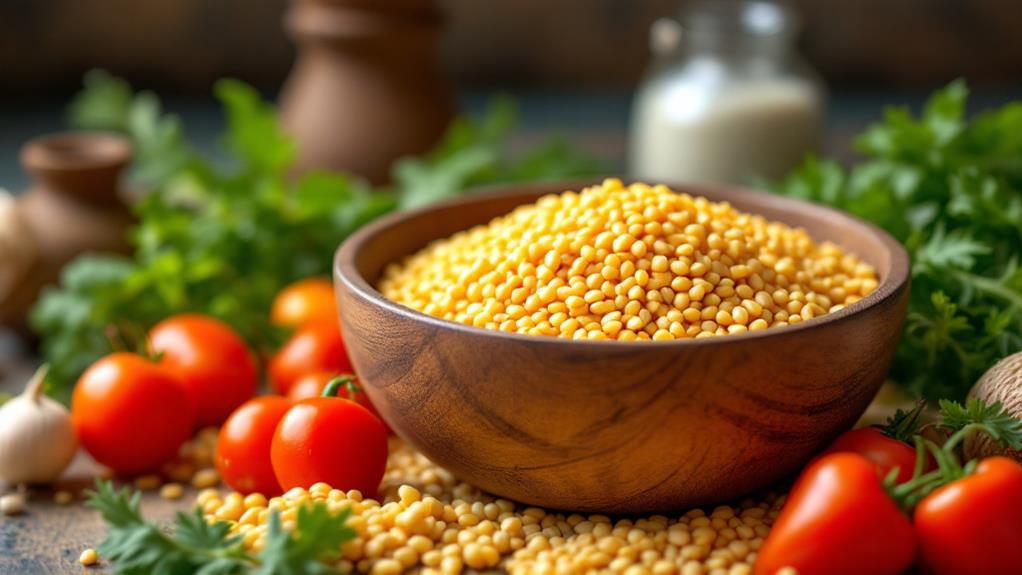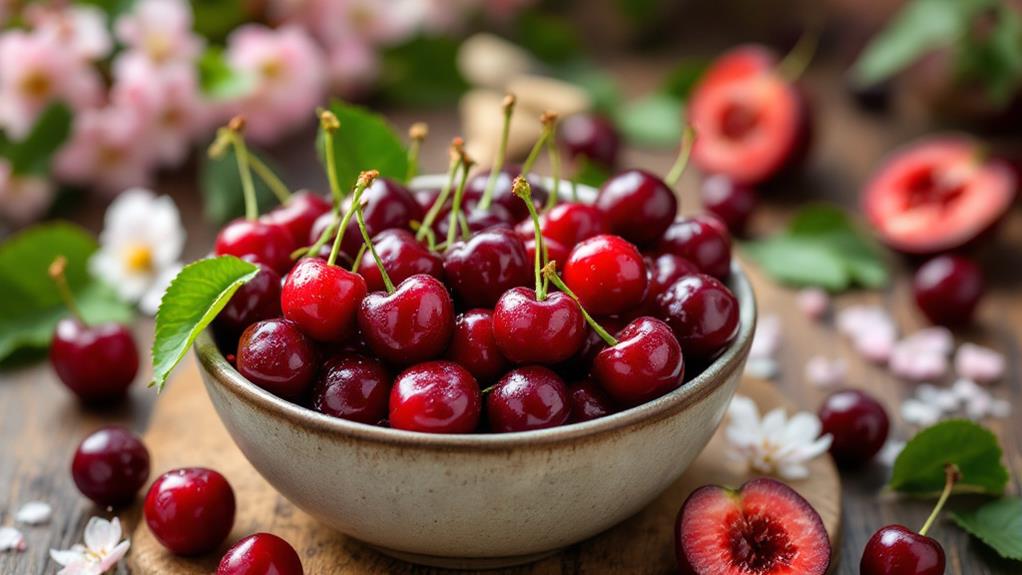The Ultimate Guide to the Types and Benefits of Sapodilla (Sapota) Fruit
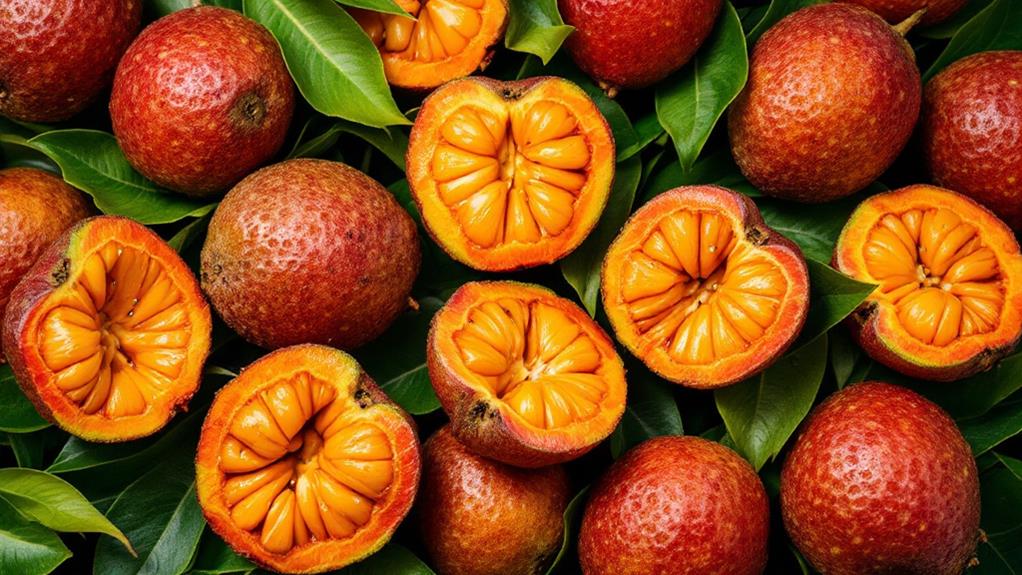
If you crave a sweet, healthy snack, sapodilla—or sapota—is a fantastic choice. Native to tropical regions, this "brown sugar fruit" delights with its malty flavor while offering numerous health benefits. It's rich in dietary fiber, Vitamin C, antioxidants, and minerals like potassium and copper, which enhance digestion, immunity, and energy levels. You can enjoy sapodilla in smoothies, baked goods, or even traditional dishes. With varieties like Black Sapote and Alano, there's plenty to investigate. Remember to pick mature fruits and store them properly for the best experience. There's much more to discover about this versatile fruit's uses and benefits.
Understanding Sapodilla Fruit
Sapodilla, scientifically known as Manilkara zapota, is an intriguing fruit worth understanding. Native to Mexico, the Caribbean, and Central America, this evergreen tree produces round or egg-shaped fruits celebrated for their sweet, malty flavor, which earns them the nickname "brown sugar fruit." As you investigate its benefits, you'll find sapodilla offers more than just delightful taste; it's a powerhouse of health advantages.
Incorporating sapodilla into your diet introduces significant amounts of dietary fiber, vital for digestion and maintaining a healthy gut. This fruit is rich in nutrients, offering a good dose of Vitamin C, which enhances your immune system and helps in the absorption of iron. The antioxidants present, including polyphenols and flavonoids, play an important role in combating oxidative stress, potentially reducing the risk of chronic diseases like heart disease and cancer.
Sapodilla thrives in tropical climates, making it available year-round in many regions. Its high nutrient content and health benefits make it a valuable supplement to any diet. By including sapodilla, you're not only enjoying a delicious fruit but also supporting your comprehensive health with its wealth of nutrients and antioxidants.
Nutritional Composition
Exploring the health benefits of sapodilla naturally leads to understanding its nutritional composition, which plays a key role in its impact on well-being. Sapodilla is a powerhouse of nutrients that support numerous bodily functions. With approximately 141 calories in a 6-ounce serving, it's a relatively low-calorie option, making it a great choice for mindful eaters. The fruit is rich in carbohydrates, providing about 34 grams per serving, mostly from natural sugars that offer a quick energy boost.
One of sapodilla's standout features is its high fiber content. Packing around 9 grams of fiber, it considerably improves digestive health by promoting regular bowel movements. This fiber content helps you feel full longer, which is ideal for maintaining a balanced diet. Sapodilla is also a fantastic source of important vitamins, particularly Vitamin C. With 28% of the daily value in just one fruit, it strengthens your immune function and aids in collagen production.
Moreover, sapodilla provides significant minerals like Copper and small amounts of iron. Copper supports energy production, while iron is essential for hemoglobin formation. Furthermore, its antioxidant properties contribute to general vitality, making sapodilla a valuable addition to your diet.
Health Advantages
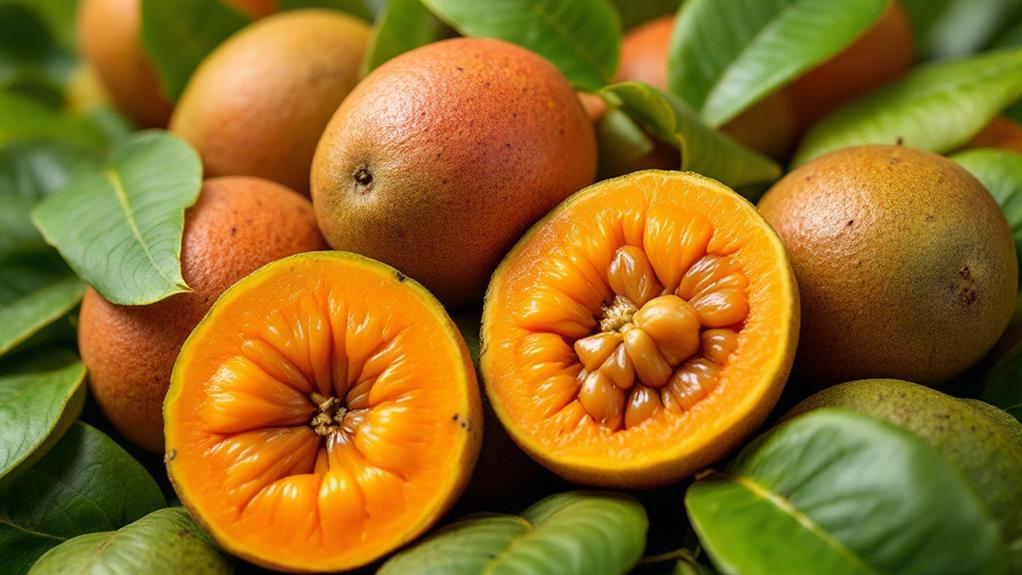
Delving into the health advantages of sapodilla reveals a nutrient-rich fruit that offers numerous benefits. This tropical delight is packed with dietary fiber, providing around 9 grams per fruit, which promotes regular bowel movements and aids digestion. By incorporating sapodilla into your diet, you can enjoy one of its key health benefits: improved digestive health.
Sapodilla is also an excellent source of Vitamin C, delivering approximately 25 mg per fruit. This vital vitamin elevates your immune system, supports collagen production, and aids in wound healing. The fruit's high antioxidant content, including polyphenols and flavonoids, plays a significant role in combating oxidative stress, which is linked to chronic diseases. By reducing oxidative stress, antioxidants help protect your body's cells from damage and may lower the risk of chronic diseases.
For heart health, sapodilla is a wise choice. Its significant potassium content helps regulate blood pressure and lower cholesterol levels, contributing to comprehensive cardiovascular well-being. Moreover, each fruit contains about 0.146 mg of copper, supporting energy production, iron metabolism, and brain development. Enjoying sapodilla regularly can be a delicious and effective way to improve your health and protect against different ailments.
Culinary Applications
In relation to culinary applications, the sapodilla fruit's sweet, malty flavor makes it a delightful improvement to a variety of dishes. Its culinary versatility shines as you investigate its uses in both sweet and savory recipes. With a sweet aroma reminiscent of brown sugar, sapodilla turns ordinary desserts into extraordinary ones. Blend it into smoothies or milkshakes for a revitalizing treat, or bake it into pies and soufflés to elevate both flavor and nutritional value.
You can also enjoy sapodilla year-round by transforming it into jams, jellies, and preserves. These allow the fruit's rich taste to linger even when it's out of season. Its flesh, contributing a natural sweetener quality, can be tossed into fruit salads or mixed into baked goods, providing moisture and a nutritional enhancement.
Sapodilla's unique dishes showcase its global appeal; in Indonesia, it's fried, while in the Bahamas, it's mashed into pancakes. These creative uses highlight its potential to improve diverse culinary traditions. Regardless of you're incorporating it into a dish or enjoying it fresh, sapodilla's malty flavor and sweet aroma make it an exciting supplementary addition to your kitchen repertoire.
Sapodilla Varieties
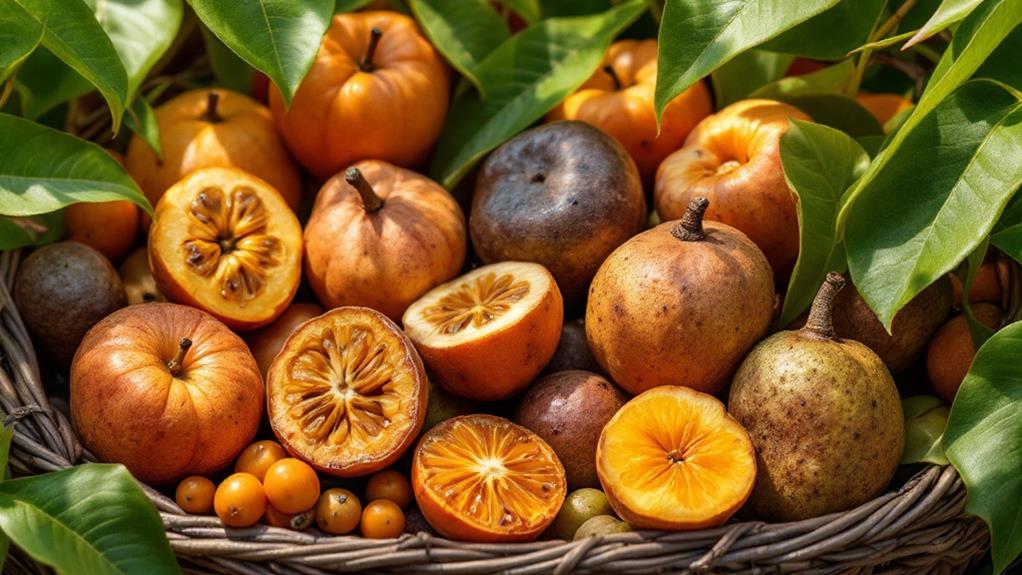
As you investigate the sapodilla's culinary versatility, you'll find that its diverse varieties offer a range of flavors and textures that can improve any dish. Among these sapodilla varieties, the Black Sapote stands out with its dark flesh and chocolate-like flavor, making it an intriguing choice for dessert lovers. The Alano, on the other hand, is often favored for its sweet taste and smooth texture, making it a delight in both fresh and cooked forms.
If you're exploring Indian flavors, the Kanchik variety might catch your interest. Known for its grainy texture and rich sweetness, it's a popular choice in desserts. The Patanjali sapodilla, with its large size and high sugar content, produces hefty fruits that can weigh up to 200 grams, offering a generous portion of natural sweetness.
In tropical regions, the Haitian sapodilla, also known as Chicozapote, is widely cultivated for its round shape and juicy, sweet flesh. Finally, the Borneo sapodilla captivates with its unique flavor profile, combining caramel and brown sugar notes, making it a favored ingredient in local cuisines. Each variety brings something special to the table, enriching your culinary experiences.
Choosing and Storing
Selecting the perfect sapodilla requires a keen eye and a gentle touch. When you're choosing sapodillas, focus on finding mature fruits that have smooth, unblemished skin and give slightly under gentle pressure—these are signs of ripeness. Avoid any with blemishes or overly soft spots. Properly storing your sapodillas guarantees they remain delicious and safe to eat. Here's what to do:
- Refrigerate Ripe Fruits: Once ripe, store sapodillas in the refrigerator. They'll stay fresh for up to one week.
- Ripen Unripe Fruits: Keep unripe fruits at room temperature. They'll need about 7-10 days to fully ripen.
- Speed Up Ripening: Place unripe sapodillas in a paper bag with a banana. The ethylene gas from the banana helps them ripen faster.
- Avoid Extremes: Keep sapodillas away from direct sunlight and extreme cold to maintain their texture and flavor.
Before enjoying your sapodilla, always wash it thoroughly to remove pesticides and guarantee safe eating. This step is essential for your health and improves the fruit-eating experience. With these tips, you'll savor perfectly ripe sapodillas every time!
Potential Side Effects

Enjoying sapodilla fruit comes with its own set of precautions. Overconsumption can lead to digestive discomfort due to its high sugar content. You might experience bloating, gas, or diarrhea if you indulge in too much. It's crucial to consume sapodilla in moderation to avoid these symptoms. Pay attention to the ripeness of the fruit, as unripe fruit contains tannins that can cause mouth irritation and throat inflammation. This can be particularly bothersome if you're sensitive or have a history of oral reactions.
If you happen to ingest sapodilla seeds, be cautious. They may contain toxic compounds that can lead to abdominal pain and vomiting. As such, it's best to remove seeds before consuming the fruit. Allergic reactions, though rare, might occur. Be on the lookout for signs like skin rashes, itching, swelling, or even breathing difficulties.
For young children, extra caution is advised. The risk of irritation from unripe fruit or accidental ingestion of seeds can pose a problem. Make sure any sapodilla they consume is fully ripe and seed-free. By being mindful of these factors, you can safely enjoy the sweet taste of sapodilla.
Exploring Sapodilla's Origins
While it's significant to be cautious about consuming sapodilla, understanding where this intriguing fruit comes from can improve your appreciation of it. Sapodilla, scientifically known as Manilkara zapota, is native to Mexico, the Caribbean, and Central America. These areas offer the warm, moist climates that sapodilla trees thrive in, growing up to 98 feet tall. You might hear sapodilla called different names around the world, such as chikoo in India, or chicozapote in certain regions. The tree starts bearing fruit about 3-4 years after planting. The fruit itself is round or egg-shaped, with its ripe state marked by a brown, rough skin.
Here's a breakdown of sapodilla's fascinating origins and global spread:
- Native Regions: Originates from Mexico, the Caribbean, and Central America.
- Common Names: Known as chikoo in India and chicozapote in some areas.
- Cultivation: Now cultivated in tropical regions worldwide, including the Philippines, India, South Africa, Australia, and South America.
- Growth: Trees can reach impressive heights and start producing fruit relatively soon after planting.
Understanding these aspects of sapodilla's origins can deepen your connection to this delightful tropical fruit.



